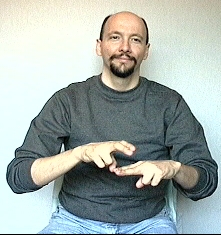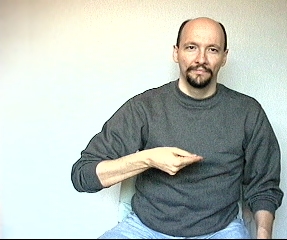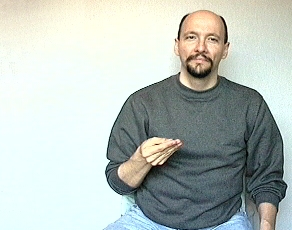I understand the concept of "eye gaze"
I understand the concept of "Noun-Verb Pairs"
I can recognize and sign numbers 31-99
I understand the concept of Directional Verbs
I am able to recognize and sign the practice sentences and story for this lesson
I have taken the Lesson 5 Quiz
I am done with Lesson 5
Vocabulary
CAN
CAR [ DRIVE]
CHURCH
COMPUTER
DOCTOR/[nurse]
EMAIL
GIVE
HOME
INTERNET
IN/[OUT]
MOVIE
PLAY
PUT [also see
MOVE]
SIT
STAND
STAY
STORE
VIDEO
WALK-TO
WATCH
WITH
Practice sheet: 5.A
1. CAN YOU UNDERSTAND ME?
[Can you understand me?]
2. NAME YOUR FAVORITE CAR (Wh-Q)
[What is your favorite car?]
3. YOU WALK-TO CHURCH?
[Do you walk to church?]
4. YOUR MOM NURSE?
[Is your mom a nurse?]
5. YOUR GRANDMA GIVE YOU WRISTWATCH?
[Did your grandmother give you a watch?]
6. YOUR FAVORITE INTERNET S-I-T-E WHAT?
[What is your favorite Internet site?]
7. WHAT YOUR FAVORITE MOVIE?
[What is your favorite movie?]
8. YOU HAVE FAVORITE CHAIR?
[Do you have a favorite chair?]
9. YOU WANT GO STORE?
[Do you want to go to the store?]
10. YOU LIKE SIGN WITH DEAF?
[Do you like signing with a Deaf person?]
![]()
Practice Sheet 5.B
1. CAN YOU DRIVE?
[Can you drive?]
2. YOU DRIVE HERE FROM HOME?
[Did you drive here from home?]
3. HOW-MANY COMPUTER YOU HAVE?
[How many computers do you have?]
4. YOU NEED GO DOCTOR?
[Do you need to go to a doctor?]
5. YOU HAVE EMAIL YOUR HOME?
[Do you have e-mail access at home?]
6. WHERE YOUR HOME?
[Where is your home?]
7. YOU LIKE PLAY OUTSIDE?
[Do you like to play outside?]
8. YOU FEEL ANXIOUS?
[Are you feeling anxious?]
9. YOUR FAVORITE STORE WHAT?
[What is your favorite store?]
10. YOU LIKE SIGN WITH FRIEND?
[Do you like signing with a friend?]
![]()
Practice Sheet: 5.C
1. CAN YOU F-I-X COMPUTER?
[Can you fix computers?]
2. YOU LIKE DRIVE?
[Do you like driving?]
3. YOU DRIVE-TO CHURCH?
[Do you drive to church?]
4. YOU LIKE EMAIL?
[Do you like using email?]
5. YOU WANT GO HOME?
[Do you want to go home?]
6. YOU WANT GO OUTSIDE?
[Do you want to go outside?]
7. YOU LIKE PLAY C-H-E-S-S?
[Do you like to play chess?]
8. YOU THINK TEACHER NEED STAND?
[Do you think teachers should stand]
9. YOU HAVE MANY VIDEO INDEX-(point off to side) HOME?
[Do you have many videos at home?]
10. ALL YOUR FRIEND SIGN?
[Do all of your friends sign?]
![]()
Practice Sheet: 5.D
1. CAN YOU SPELL HIS/HER NAME?
[Can you spell his (or her) name?]"
2. YOU DRIVE SLOW?
[Do you drive slowly?]
3. ALL YOUR FRIEND HAVE COMPUTER?
[Do all your friends have a computer?]
4. YOUR DAD GIVE-YOU COMPUTER?
[Did your dad give you a computer?]
5. YOU HAVE INTERNET INDEX-(point off to the side) HOME?
[Do you have Internet access at home?]
6. YOU LIKE GO MOVIES?
[Do you like going to the movies?]
7. YOU THINK CHILDREN SHOULD PUT-(away) THEIR TOYS?
[Do you think children should put away their toys?]
8. YOU LIKE STAY HOME WATCH VIDEO?
[Do you like to stay home and watch a video?]
9. YOU WALK-TO SCHOOL?
[Do you walk to school?]
10. YOU LIVE WITH YOUR MOM-DAD?
[Do you live with your parents?]
![]()
Story 5
MY BROTHER NOT GO SCHOOL. HE [negative "not"]-FEEL-GOOD. STAY HOME, COMPUTER SIT-[long time] PLAY-[long time], INTERNET, EMAIL HIS FRIEND. HE WANT WATCH MOVIE. MOM DRIVE-TO VIDEO STORE. GIVE-[to him].
I THINK HE SHOULD GO DOCTOR HE-[point to brother]. (Note: Sign this story with the facial expressions and body language of a jealous sibling).
![]()
Discussion:
When ASL students are first starting out I often get the question, should I watch the hands or try to watch the face. The word "try" in regards to watching the face indicates that they feel that they miss a lot of information if they aren't watching the signers hands. Beginners who focus on watching the hands sometimes look as if they were trying to keep their eyes on a fly buzzing around in front of them.
In personal one on one conversations you should indeed watch the signer's face and not focus on the hands. After enough practice you will find yourself "catching" the signs via your peripheral vision.
There is a time to watch the hands though. Suppose you are sitting in an audience watching a skilled ASL user give a speech or lecture. If you are "hearing" (meaning if you are a person who has the ability to hear) and there is a sign-to-voice interpreter who is voicing the lecture, you may wish to focus on the lecturer's hands more closely so you can pick up new signs.
If you are signing with a Deaf person and one of your hearing friends calls out your name or comes up and starts speaking to you while the Deaf person is signing to you, don't knee jerk react by looking away in the middle of your conversation to see who is calling your name or what your friend wants. Instead, keep your eyes on the signer while simultaneously holding up an index finger in the "wait a minute gesture" toward the interrupting friend. Then, after the Deaf person has finished his comment go ahead and see what your friend needs. Also be aware that it is rude to chatter away (voicing) in front of a Deaf person without signing as if the Deaf person isn't even there. If you need to say more than a few words to your hearing friend-- politely excuse yourself from your ASL conversation so the Deaf person won't be left hanging.
As the receiver in an ASL conversation you keep your eyes on the signer. But if you are the signer you will be using your eye gaze to add meaning and support to your signing. For example, if you are going to set up a pronoun or absent referent [see Indexing] you will glance to some area in space that you will associate with the referent for the rest of your conversation.
Something that often confuses beginning signers is a Deaf person will start signing to and looking at an imaginary person. You may be tempted to look over your shoulder to see if that person is really there. Try to stifle the urge. In ASL we often turn our bodies and sign to a spot in mid air as if we were having "real-time" conversation, when in fact we are just using an ASL principle of role-taking instead of using the English method of saying, "he said" and "she said" before quoting.
Sometimes a Deaf person will look away for a moment while he is thinking of his next sign. That prevents you from thinking that it is your turn to talk.
As part of a turn taking strategy--when one person is ready at that moment to take his turn and not wait for the other person to finish--he can look away and start signing.
I see (and occasionally use) the look-away technique during heated discussions where both persons are trying to make their points. I don't recommend you try that until you have an extremely good relationship with the other person.
Good ASL storytellers use eye gaze to model the characters in their story as the characters communicate with each other (short person looking up, tall person looking down, etc.)
![]()
Noun-Verb Pairs:
These are signs that use the same handshape, location, and orientation, but
have a different movement. The verb of a noun verb pair generally has a
single, continuous movement that is larger than the movement of the
noun. The motion of a noun of a noun verb pair is generally a double
movement that is smaller than that of a verb.
Got that? Verbs (of noun/verb pairs) use a
single movement.
Nouns? (of noun/verb pairs) use a double movement.
A good example of a noun verb pair is the "CHAIR/SIT."
If I do this motion once, it means sit.


If I do the movement twice, it means CHAIR.
![]()
Directional Verbs: ASL has many verbs that incorporation information about the subject and object (the doer and receiver of the action). That means you don't have to use a separate sign for the subject and/or object when you use a directional verb. This is known as "agreement." Or "subject-object agreement."
A good example of this kind of sign is "GIVE."
If I wanted to indicate "HE GAVE IT TO ME," all I'd need to do is start the
sign "GIVE" from a location that is farther away from my body and end the
sign nearer to my body.


On the other hand, if I wanted to indicate, "I gave it to him, I'd sign:


Visit the "GIVE" page for more
examples of this sign.
![]()
Numbers 31-99: Just show the first digit and then the second digit. For example, 31 would be shown as a 3 and a 1:


Note: There are some special cases where some of the numbers are modified. Plus there several variations on various numbers, but we will save those discussions for more advanced classes.
![]()